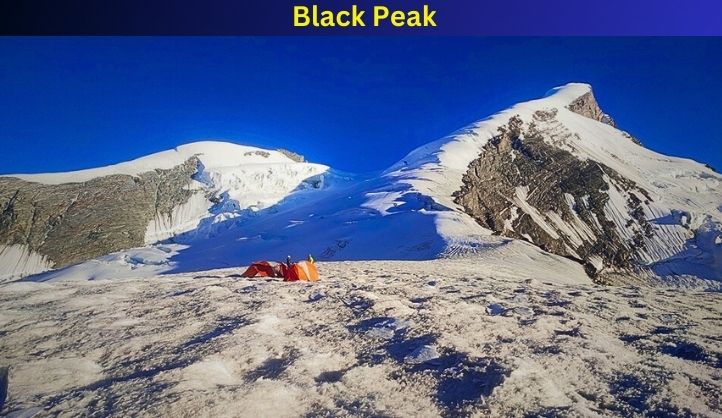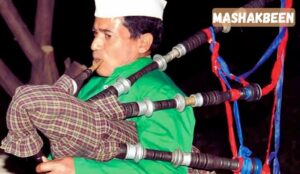Towering over the Garhwal Himalayas, Black Peak, also known as Kalanag, beckons adventure seekers with its daunting beauty and rich history. This majestic mountain, reaching a height of 6,387 meters (20,986 ft), is the crown jewel of the Bandarpunch massif, offering a challenging climb and unparalleled views for those who dare to conquer its slopes.
Unveiling the Mystery
The name Kalanag translates to “Black Cobra” in Hindi. Legends abound about the peak’s name. Some say the permanent snow cover on its face resembles the raised hood of a cobra, while others believe the constantly shifting shadows cast by the peak create the illusion of a snake’s movement. The true origin might be lost to time, but the name adds a touch of mystique to this already captivating mountain.
A Climber’s Challenge
Black Peak is not for the faint of heart. The trek itself is an adventure, passing through the Govind National Park, a haven for diverse flora and fauna. Lush meadows, towering pine forests, and dramatic glacial landscapes paint a breathtaking backdrop for your journey. The official base camp, Kyarkoti, nestled at 4,050 meters (13,300 ft), offers stunning views of the surrounding peaks, including Swargarohini, Bhagirathi massif, and the majestic Bandarpunch range.
The climb itself is a demanding one, requiring excellent physical fitness, mountaineering experience, and a strong sense of adventure. The route involves navigating technical terrain, including steep ascents, crevasses, and potentially challenging weather conditions. Proper acclimatization is crucial, as the high altitude can cause altitude sickness if not respected.
Many trekking companies in Uttarakhand offer guided Black Peak expeditions. These expeditions typically last for two to three weeks, with expert guides ensuring your safety and providing technical support throughout the journey.
Map of Black Peak (Kalanag)
The Trek Itinerary – A Gradual Ascent
The Black Peak trek typically follows a well-established route, with several campsites along the way. Here is a general overview of the itinerary:
-
Day 1 Sankri (1920 m) – Drive from Dehradun or Rishikesh to Sankri and check into your guesthouse or homestay.
-
Day 2 Sankri (1920 m) – This day is usually reserved for briefing and equipment checks by your guides. You can also use this time to explore the surroundings of Sankri.
-
Day 3 Sankri (1920 m) – Taluka (1700 m) – Osla (2560 m): The trek begins with a drive from Sankri to Taluka, followed by a moderate hike to Osla through beautiful forests and meadows.
-
Day 4 Osla (2560 m) – Ruinsara Tal (3537 m): This day’s trek takes you to the scenic Ruinsara Lake, offering stunning views of the surrounding peaks.
-
Day 5 Ruinsara Tal (3537 m) – Kyarkoti (3850 m): The journey continues towards Kyarkoti, the base camp for Black Peak, where you’ll establish camp and start the acclimatization process.
-
Day 6 & Onwards Kyarkoti (3850 m) – Summit Push and Descent: The following days involve climbing stages with increasing difficulty, technical sections like the Black Wall, and high-altitude camps. The exact itinerary will vary depending on the chosen expedition company and weather conditions. The summit push itself is a strenuous undertaking requiring excellent fitness and proper acclimatization.
Beyond the Summit – The Legacy of Kalanag
The first successful summit of Black Peak was recorded in 1955 by a team led by schoolmaster Jack Gibson and students from The Doon School, Dehradun. This historic climb marked the beginning of a rich mountaineering tradition associated with Black Peak.
Black Peak holds immense significance for mountaineers, especially those looking to hone their skills and gain experience for even higher Himalayan expeditions. However, the true reward of conquering Black Peak goes beyond the summit itself. It’s about pushing your limits, experiencing the raw beauty of the Himalayas, and forging a deep connection with nature.
Planning Your Black Peak Expedition
There are some key considerations for planning your trip.
- Season – The ideal time to climb Black Peak is between May and June and September and October. These months offer relatively stable weather conditions with clear skies and minimal snowfall.
- Experience and Fitness – It is a challenging climb. Ensure you have a good level of physical fitness and prior mountaineering experience.
- Training – A rigorous training program focused on cardio, strength, and endurance is essential for preparing your body for the demands of the climb.
- Permits and Insurance – Obtaining the necessary permits from the Indian Mountaineering Federation (IMF) is crucial. Additionally, comprehensive mountaineering insurance is highly recommended.
- Gear and Equipment – Invest in high-quality mountaineering gear specifically designed for high-altitude environments. This includes a sturdy backpack, appropriate clothing layers, crampons, an ice axe, and a robust tent for withstanding harsh weather conditions.
A Beacon for Adventure
Black Peak is more than just a mountain; it’s a symbol of adventure, resilience, and the human spirit’s yearning to conquer new heights. If you’re an experienced climber seeking a challenging yet rewarding expedition, Black Peak beckons.
- Ethical Considerations – Respect the fragile mountain ecosystem. Practice responsible trekking by minimizing waste, respecting local flora and fauna, and leaving no trace behind.
- Embrace the Challenge – Black Peak is not for the casual trekker. Be prepared for physical and mental exertion, unpredictable weather conditions, and the ever-present challenge of high altitude.
- Celebrating the Journey – The true essence of the Black Peak expedition lies in the journey itself. Savor the breathtaking scenery, appreciate the camaraderie with fellow climbers, and embrace the unique cultural experiences along the way.
Nearby Places to Explore
Govind Pashu Vihar National Park
Sankri serves as the gateway to the Govind Pashu Vihar National Park, a haven for diverse flora and fauna. The park boasts lush meadows, dense forests, and snow-capped peaks, offering a plethora of trekking opportunities. Keep your eyes peeled for elusive species like the Himalayan tahr, musk deer, and even the majestic snow leopard.
Gangotri and Yamunotri Dhams
If you have additional time and are looking for a pilgrimage experience, consider visiting the holy towns of Gangotri and Yamunotri, the sources of the Ganges and Yamuna rivers respectively. These sacred sites are located roughly 80-100 kilometers from Sankri and can be reached by car or taxi.
Dodital Lake
For a more relaxed excursion, explore the Dodital Lake, a scenic freshwater lake surrounded by dense pine forests. The lake offers opportunities for boating, fishing, and bird-watching.
Har ki Dun Valley
For the more adventurous, consider the Har ki Dun Valley trek, a moderate to challenging route that leads to a breathtaking Himalayan valley. The trail offers stunning views of Swargarohini, Bandarpoonch, and other peaks.
Conclusion
Black Peak is a formidable yet rewarding climb. By understanding the technical aspects, honing your skills, prioritizing safety, and embracing the challenges, you can embark on a journey that will test your limits and leave you with an unforgettable sense of accomplishment. Remember, the true essence of Black Peak lies not just in reaching the summit but in the experience itself: the camaraderie, the breathtaking scenery, and the deep connection it fosters with the awe-inspiring Himalayas.
FAQs About Black Peak (Kalanag)
What is the difficulty level of the Black Peak expedition?
Black Peak is a challenging climb suitable only for experienced mountaineers with excellent physical fitness and prior experience in high-altitude mountaineering.
What is the ideal time to climb Black Peak?
The best window for climbing Black Peak is between May and June and September and October. These months offer relatively stable weather conditions with clear skies and minimal snowfall.
What permits are required for the Black Peak expedition?
Obtaining permits from the Indian Mountaineering Federation (IMF) is mandatory. Additionally, comprehensive mountaineering insurance is highly recommended.
How do I reach Sankri, the base camp for Black Peak?
Sankri is well connected by road from major cities like Dehradun and Rishikesh. Public buses and taxis are readily available. The journey typically takes 7-8 hours by road.
What kind of physical fitness is required for the Black Peak expedition?
A rigorous training program focused on cardio, strength, and endurance is essential. Black Peak involves strenuous ascents, carrying backpacks, and navigating challenging terrains at high altitudes.
What gear and equipment do I need for the Black Peak expedition?
Invest in high-quality mountaineering gear, including a backpack, appropriate clothing layers, crampons, an ice axe, a sturdy tent suitable for high altitude conditions, and proper mountaineering boots.
Is it safe to climb Black Peak alone?
Not. Black Peak is a serious undertaking, and attempting it without a qualified guide and a well-equipped team is extremely dangerous.
What is the environmental impact of trekking in the Himalayas?
Practice responsible trekking by minimizing waste, respecting local flora and fauna, and following proper waste disposal techniques. Leave no trace behind and help preserve the fragile mountain ecosystem.





